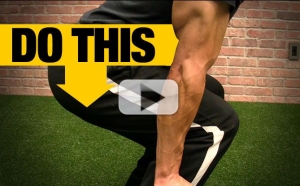The squat is one of the most important exercises you can include in your leg training. That said, if you experience knee pain while doing it or just don’t have the strength you think you should with this staple leg exercise, then you need to watch this video. I’m going to show you one thing you need to do before any squat that will instantly help you decrease knee discomfort and put more weight on the bar as you realize your true strength.
The effectiveness of this relies on the dysfunctional recruitment of the posterior chain (namely the glutes and hamstrings) that most of us have from muscle imbalances we have developed over time. When you perform a squat you need to be able to load the muscles on the back side of our bodies to handle as much weight as we are capable of. All too often, we tend to shift the load too much to the anterior chain muscles which winds up hurting our knees and limiting the amount of weight we can lift.
There are two major requirements of a properly performed squat biomechanically. You need to have proper amounts of knee flexion and hip flexion. One without the other can lead to one ugly looking squat. That said, if you can marry the two and optimize the contributions of each you are going to have a squat that is not only capable of handling maximal loads but is going to do so as safely as possible on your joints.
That said, since we know the squat is a glute driven movement it makes sense that in order to neurologically wake up the posterior chain we would want to perform a quick warmup with an exercise that does so directly. In this case, it’s a weighted glute bridge or a barbell hip thrust depending on your available hip range of motion and level of training experience.
I like to start everyone on the floor if they have not done this exercise prior to squats before. The key to the effectiveness of the movement is that it trains the glutes to be the primary driver of hip extension while working in concert with the hamstrings (which is their secondary function). With both the knees and hips in flexion, we are better mimicking the true function of the lower body during the squats.
When you perform your weighted bridge you want to be sure that you are feeling the hinge take place in your hips. A lot of times, the proprioceptive awareness of what true hip hinging should feel like is lacking. This leads to an overreliance on the quads to try and take the brunt of the load on the squat. After performing the bridge however, the glutes are more prepared to allow the posterior loading of the body during the descent. Likewise, the hamstrings are more alert to their role as eccentric controllers of hip flexion during the down portion of the squat and are therefore more capable of giving you stability that you have not had.
On the way up, the activation of the glutes provides you with keys to the ignition of the main driver of the ascent on the squat. While the quads are important for getting out of the hole, it’s the glutes that are primarily responsible (with their immense strength capacity) for getting you up and out with minimal disruption to your bar path. Those with weak glutes will demonstrate ugly looking squat form out of the whole. Often times, these guys and gals will lurch their bodies forward, raising the hips and shifting the load to their low backs to compromise for their weaknesses in the glutes.
Over time, this will lead to chronic low back pain and is completely avoidable.
A couple sets of 6-8 reps of the barbell glute bridge or barbell hip thrust with a 4 second hold at the top is enough to warm up the body to perform the squat to your maximum potential. Neurologically this will allow you to tap into strength reserves you never knew you had all while building up your volume over time through your other leg training on the glutes and posterior chain muscles.
If you are looking for a step by step program that never overlooks the importance of the glutes when it comes to athletic performance and obtaining your most powerful physique, head to the link below and check out the ATHLEAN-X Training System.
For more videos on how to build a bigger squat as well as the best way to strengthen your glutes and avoid red flags for weak glute development, be sure to subscribe to our channel at the link below and turn on your notifications so you never miss a video when it’s published.

Jeff Cavaliere M.S.P.T, CSCS
Jeff Cavaliere is a Physical Therapist, Strength Coach and creator of the ATHLEAN-X Training Programs and ATHLEAN-Rx Supplements. He has a Masters in Physical Therapy (MSPT) and has worked as Head Physical Therapist for the New York Mets, as well as training many elite professional athletes in Major League Baseball, NFL, MMA and professional wrestling. His programs produce “next level” achievements in muscle size, strength and performance for professional athletes and anyone looking to build a muscular athletic physique.
































